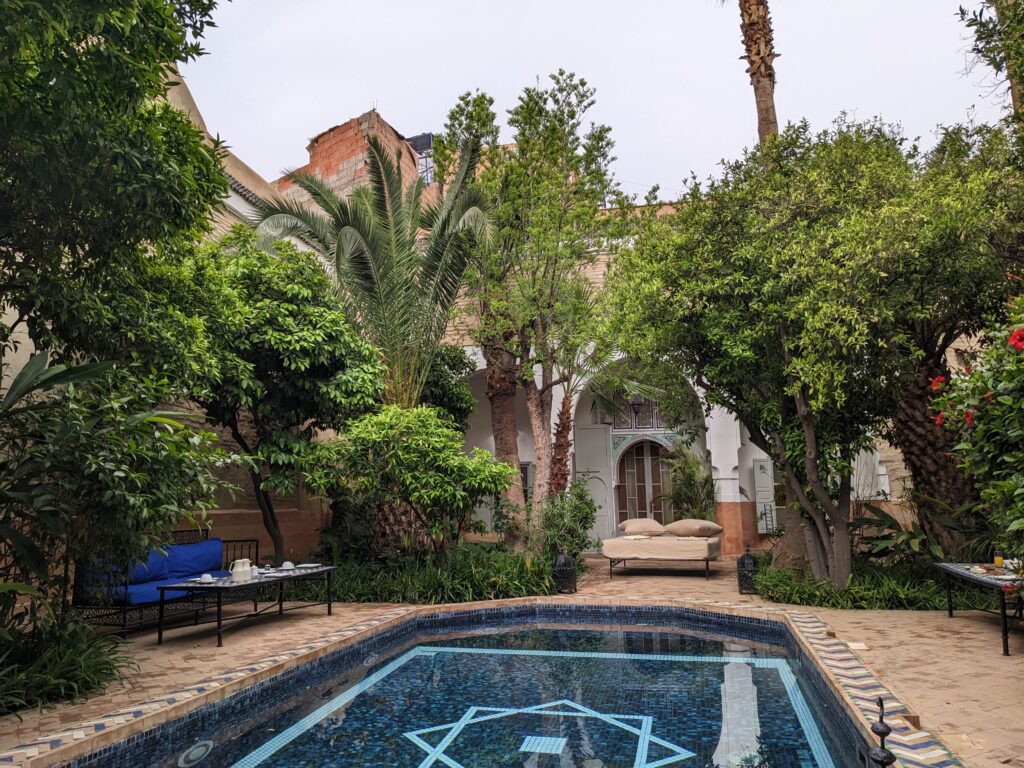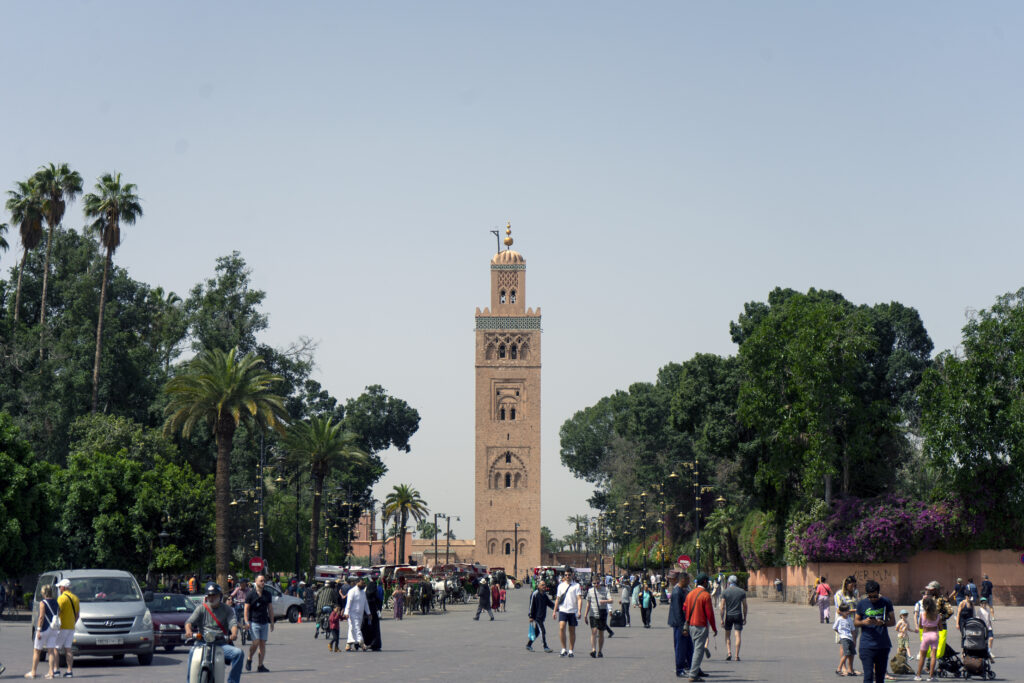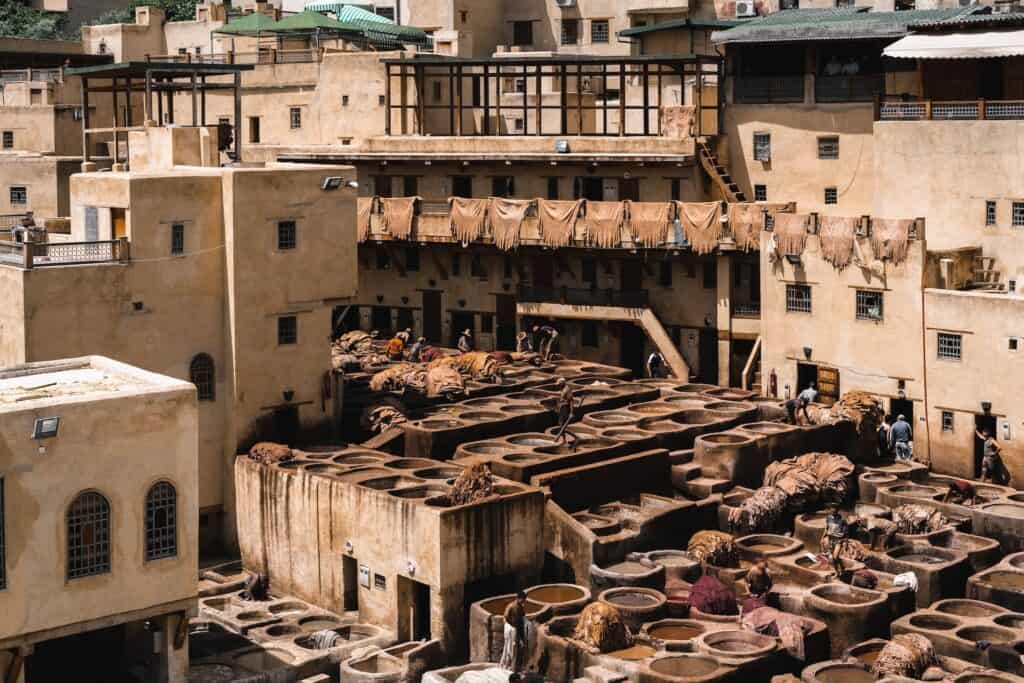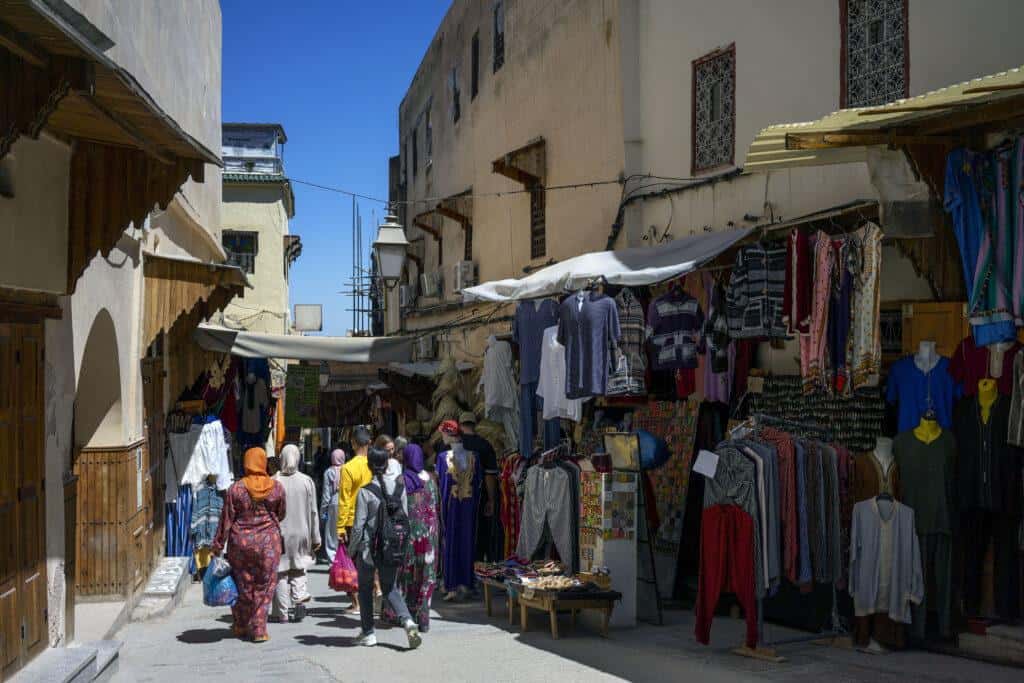Last Updated on October 26, 2023
Knowing what not to do in Marrakech will set you up to have a smooth, worry-free time in this incredible Moroccan city.
Marrakech, also spelled Marrakesh, was founded between 1070 and 1072 by the Almoravids. Located in central Morocco, it’s one of the country’s imperial cities. The oldest part of the city, known as the medina, was designated a UNESCO World Heritage site in 1985.
Marrakech is a beautiful city filled with history, museums, delicious food culture, beautiful architecture, and culture that is all worth learning about.
If you’re headed to Marrakech, read on to find out what not to do in Marrakech. You’ll learn must-know Marrakech travel tips, including the Moroccan customs visitors should know, and how to hail the right type of taxi.
Disclosure: This article includes affiliate links. This means that if you make a purchase through one of those links, I earn a small commission. Affiliate links cost you nothing to use, and keep Pina Travels reader-supported. Thank you!
- What Not to Do in Marrakech: 15 Important Travel Tips!
- 1. Don’t Stay Outside of the Medina
- 2. Don’t Book a Hotel (Book a Riad Instead!)
- 3. Don’t Drink Tap Water in Marrakech
- 4. Don’t Forget to Wander the Medina
- 5. Don’t Accept Unsolicited Help or Directions
- 6. Don’t Be Afraid to Speak Up
- 7. Don’t Engage in Animal Tourism
- 8. Don’t Forget to Learn About Local Customs
- 9. Don’t Get Into Taxis Without Agreeing on Price
- 10. Don’t Take Photos Without Permission
- 11. Don’t Forget to Download an Offline Map App
- 12. Don’t Carry Large Bills of Moroccan Dirhams
- 13. Don’t Barter for Unfair Prices
- 14. Don’t Forget to Day Trip From Marrakech
- 15. Don’t Forget To Practice Second City Tourism
- Final Thoughts: What Not to Do in Marrakech

What Not to Do in Marrakech: 15 Important Travel Tips!
1. Don’t Stay Outside of the Medina
The medina in Marrakech is truly the best area to stay in in the city, especially for first-timers. If you stay in this historic neighborhood, you will be in the heart of the city, and within walking distance to the most famous attractions.
The reason staying outside the medina makes the “what not to do in Marrakech” list is that it’s very inconvenient. Most of the sites you’ll want to see in Marrakech, like the souks, Bahia Palace, and Jemaa el Fna Square are inside the medina. If you stay outside the medina, you’ll need to walk long distances, or take a cab to reach the main tourist sites in Marrakech.
2. Don’t Book a Hotel (Book a Riad Instead!)
In Marrakesh you have the option to book regular hotels. But don’t do that. Instead, book Moroccan riads for your stay. A riad is a traditional house or palace that typically has an interior open-air courtyard and garden. They’re usually multiple floors, and have multiple rooms.
The riads in Marrakech have stunning architecture and design. While some riads have been modernized, others are more traditional in their decor. What’s most amazing about the riads in Marrakech is how quiet they are. When you step into a riad off the busy streets of the medina, you’ll notice it’s suddenly calm and quiet, a nice respite from the bustling city.
In the past, riads were the estates of Morocco’s wealthiest citizens, merchants, and courtiers. But today, many of the riads in Marrakech have been converted to hotels. A visit to Morocco is not complete without a stay in one of the beautiful buildings!
You’ll find riads all over Morocco, not just in Marrakech. So if you’re debating between Fes or Marrakech, don’t worry! You can have a riad experience in Fes, too.
I stayed in Riad Laila the last time I was in Marrakech, and I highly recommend it! This beautiful riad is just a 15 minute walk away from Jamaa El Fna Square in Marrakech. It’s in a quiet part of the city which is a nice respite from how busy the medina can be! What I especially loved about Riad Laila was the friendly and helpful staff, and their beautiful garden area. In the garden there is a pool where you can cool off, and they also have a rooftop with lots of lounging areas! Our room was very comfy, and a delicious breakfast spread is included every morning. You can book Riad Laila, here!

3. Don’t Drink Tap Water in Marrakech
It’s probably best to drink filtered or bottled water when visiting Marrakech and traveling in Morocco. While most locals do drink tap water, it may not be worth the risk for visitors. You don’t want to end up with a stomach bug during your trip.
When eating at food stalls and restaurants, it’s best to buy bottled water, or bring your own filtered water. One solution is to bring a filtering water bottle with you to Morocco. Filtering your own water is a sustainable tourism practice because it will reduce how much plastic waste you generate.
There are various systems to choose from that suit different needs, but all systems have the same function: they filter contaminants out of water, making it safe to drink. There are tons of options to choose from, Lifestraw is a popular one, but I personally love my Grayl bottle.

4. Don’t Forget to Wander the Medina
What not to do in Marrakech? Don’t overplan! It’s easy to plan your days in Marrakech to be busy with activities, but this doesn’t leave much time for wandering.
The old medina in Marrakech is worth exploring without much of a plan. The medina is an old Islamic capital that dates back to the 11th century. It’s enclosed by around 16 kilometers of walls and gates. It’s made up of busy streets, alleyways, shops, food stalls, and more.
Wandering is the best way to truly get a feel for this old city. Take the time to slowly explore off of the main drag of the medina. You’ll stumble on quiet neighborhoods, beautiful alleys, and little shops.
5. Don’t Accept Unsolicited Help or Directions
It’s common to be offered unsolicited help (or directions) in Marrakech. A local will approach you, and tell you they can guide you to your riad, or wherever else you’re going.
There will be no mention of pay for this help, but once they’ve brought you to your destination, they’ll ask for an overinflated tip. Usually, they won’t leave until you’ve paid them.
In situations where you actually need the help, this isn’t a bad service to pay for. But, it’s better that you ask a police officer, or someone inside a shop. This is because you have no idea how much you will be asked to pay in exchange for the service if you go with someone who approaches you.

6. Don’t Be Afraid to Speak Up
You will likely find yourself being approached often by locals in Marrakech. They may want to offer you guidance, like I mentioned in the previous point. Or, they’ll want to take you to your shop, or sell you something right there on the spot.
In some cases, you might find yourself becoming irritated by this, especially if it happens to you often. Don’t be afraid to speak up and firmly say no. Often, this point blank statement will send the hopeful salesperson right on their way.
7. Don’t Engage in Animal Tourism
While in Marrakech, you’re guaranteed to visit Jamaa el Fna Square. In the square you’ll notice monkey handlers and snake charmers. They will invite you to interact with the animals, and take photos with them (for a fee). These monkeys and snakes are being used as props for tourist entertainment.
As harmless and fun as it might seem to pose for a photo with one of these macaques, or to give money to their handlers to watch the monkey perform tricks, it’s actually a link in the chain of the illegal trade which is threatening Barbary macaque populations in the wild.
These monkeys are captured when they are young and trained to perform. The story is similar for the snakes you’ll see with snake charmers.
It can be very hard to figure out which wildlife tourism experiences are responsible. Your safest bet in general is to avoid any animal tourism experiences that involve touching an animal, feeding an animal, or posing for a photo with an animal.
So while in Marrakech, don’t engage with the monkey handlers or snake charmers. If more and more people do this, the demand for this kind of entertainment will drop, and it will be a less common form of tourism offering in the city.

8. Don’t Forget to Learn About Local Customs
Depending on where you’re traveling to Morocco from, you might find that the culture, customs, and traditions are different from what you’re used to. And that’s okay! Learning about cultures outside our own is an exciting part of travel.
Take the time to learn about Moroccan customs and traditions, and then be respectful of them. For example, in Morocco, all genders traditionally dress modestly.
When visiting Morocco, women travelers can show cultural respect by wearing long, loose-fitting clothing that covers the upper arms, knees, chest, midriff and back. Men can show respect by covering their shoulders and their legs. Just be cautious of cultural appropriation, if you’re considering wearing traditional Moroccan clothing.
Another important custom in Morocco is etiquette around meals. If you eat in local restaurants, or are invited into a local’s home for a traditional Moroccan meal, you’ll notice that dishes are eaten with your hands instead of using cutlery. It’s also customary to eat only with the right hand.

9. Don’t Get Into Taxis Without Agreeing on Price
There are two types of taxis in Morocco. “Petite” taxis and “grand” taxis. Petite taxis seat only 3 people, and they are meant to charge you based on a metered price. A petite taxi can take you to specific locations within city limits.
Grand taxis can hold up to 8 people, and you pay a specific rate for your seat. These taxis don’t begin their trip until they are filled, or until people pay for the seats that are remaining. Grand taxis usually go to destinations further out, like to neighboring villages.
Tourists will mainly use petite taxis. Whenever you get into a petite taxi you need to ask for the meter (or use the French word because it’s more common, “compteur”).
In Marrakech, taxi drivers will often tell you that their meter is broken. In this case, decide on a price before the trip begins. In most cases, the taxi driver will start with a high price. Barter a little bit before landing on an agreed price.
10. Don’t Take Photos Without Permission
An important thing not to do in Marrakech has to do with taking photos. As with traveling anywhere, photo-taking should be intentional and respectful. In Morocco, some people will refuse being photographed for religious reasons.
So how can you be a responsible tourist when taking photos? If you would like to take a photo of a person, be sure to ask for their consent. If you intend to share a photo of someone to your social media, or any public platform, it’s important to have explicit consent to do so.
When taking photos of streets or alleys in Marrakech, be cognizant of who might end up in the frame. If you can, wait a moment until local people are out of the frame before snapping the image.
It’s also important to think about what a photo depicts. Sharing images of impoverished, or less developed communities for self-gratification is an unfortunate symptom of the White Saviour Industrial Complex.
This tip isn’t just for Marrakech – You’ll find it in my guide covering what not to do in Morocco, too. Regardless of where you travel in Morocco, be respectful when taking photos.

11. Don’t Forget to Download an Offline Map App
The only way to get around the medina in Marrakech is by walking. Some of the historic center’s streets are so narrow that only pedestrians, motorbikes, and bicycles can access this part of the city.
It’s easy to get lost in the medina in Marrakech. It’s made up of winding alleyways that intersect, and aren’t always well marked. So, what not do to in Marrakech? Don’t forget to download offline maps.
An offline map app is your best bet for ensuring you don’t get lost! While offline isn’t absolutely necessary, I recommend downloading maps to use offline *just in case* you run out of data for whatever reason.
I usually use Google Maps for my offline maps. To download an offline map of Marrakech, go into your settings, tap “Offline Maps,” and select a region to download.
12. Don’t Carry Large Bills of Moroccan Dirhams
Morocco’s currency is the dirham (MAD). Dirhams come in various denominations. There are 20, 50, 100 and 200 dirham notes in circulation, as well as coins.
While exploring Marrakech you’ll find yourself wanting to buy little things here and there. Maybe some street food or a drink, or something to take home from the souks. You may need to take a taxi, pay bus fare, or pay for a meal.
It’s best to carry small bills while in Marrakech. This makes paying simpler because the vendor won’t need to find change for you (and they won’t be able to claim that they don’t have change).

13. Don’t Barter for Unfair Prices
Being budget conscious while visiting Marrakech isn’t bad, as long as you ensure that your budgeting practices don’t go overboard, and you follow best practices for responsible budget travel.
In many countries around the world, including Morocco, bartering prices is common practice. And it’s also common that tourists will generally be asked to pay higher prices than a local would. Some people call this the “tourist tax.”
Some travelers are upset by the tourist tax, but I’d argue that it’s fair that locals maximize their income by setting prices based on what a buyer can afford, and the strength of their home currency.
If you can afford to travel, then you can afford to pay prices that are fair. And yes, that fair price may be more than what a local would pay. In practice, it is good to barter in Marrakech. I would ask the initial price, and then barter down once from there.

14. Don’t Forget to Day Trip From Marrakech
What not to do in Marrakech? Don’t just see Marrakech! While Marrakech is a beautiful and exciting city, there’s much more to Morocco. Beyond the bustling city there are deserts, mountain villages, seaside towns, and more.
Exploring beyond Marrakech will give you more insight into life in Morocco, and a well-rounded experience. Luckily, there’s plenty of day trips that run out of Marrakech, so seeing beyond the city is simple!
Here are two popular and highly-rated Marrakech day trips to consider:
Full-Day Desert and Mountain Tour
This Desert and Mountain Day Trip starts with pickup from your hotel or riad in Marrakech. You’ll then head south towards the Agafay Desert, admiring the changing landscape along the way as the city gives way to greenery.
You’ll visit the village of Imlil at the foot of the High Atlas Mountains, and pass through the Kik Plateau. Then you’ll enjoy lunch at a traditional Berber house before continuing the tour to the Great Plain of Haouz. The day ends with a tour of the Agafay Desert.
Ouzoud Waterfalls Guided Hike and Boat Trip
This full-day Ouzoud Waterfalls Tour, Hike, and Boat Trip gives you the opportunity to see beautiful nature while also learning about Berber culture. You’ll be picked up from your hotel or riad, before departing for one of the most spectacular waterfalls in North Africa, located 93 miles (150 km) north of Marrakech.
You’ll get to admire the waterfall from afar as well as up close, visit an argan oil cooperative, walk beautiful trails, go on a traditional boat ride to the bottom of the falls, and enjoy a Berber lunch.
15. Don’t Forget To Practice Second City Tourism
Second city tourism is all about exploring lesser-known destinations of a country, with the goal of exploring beyond the tourism centres. This trend has emerged as a way to address overtourism, but to also enrich travel experiences.
By traveling beyond just one city in Morocco, you can see and learn much more about this country.
If you’re visiting Marrakech, you can practice second city tourism by taking the train from Marrakech to Fes, or by taking the train to Casablanca. These are just some of the “second cities” that are easily accessible from Marrakech.
Final Thoughts: What Not to Do in Marrakech
I hope these tips for what not to do in Marrakech help you plan a worry-free, memorable trip to this awesome city. I wanted to share these because I truly believe that being an informed tourist is the best way to be a responsible tourist!
If you have tips to add, feel free to share them in the comments.
More on Morocco from Pina Travels:


Erin has been traveling for over a decade, both solo, and with her partner. She’s now traveled to countries across 6 continents, and has lived in 2 countries abroad. Erin also hosts the travel podcast, Curious Tourism, where she interviews travel industry thought leaders and experts about responsible tourism. Learn more about Erin, and get in touch with her, here.



